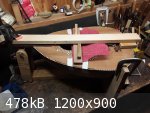Dr. Oud
Oud Junkie
    
Posts: 1370
Registered: 12-18-2002
Location: Sacramento, CA, USA
Member Is Offline
Mood: better than before
|
|
Contest!
Okay all you smart alleky oud "experts" Show your stuff. Here's the fixture, here's the contest rules:
1st prize..bragging rights - explain why this is necessary and how it got in this state.
2nd prize..same as first but not so much - name and explain the function of each component of the fixture
3rd prize.. well, no 3d prize, I'm out of ideas.
Professional luthiers are excluded, you know who you are.

|
|
|
Dr. Oud
Oud Junkie
    
Posts: 1370
Registered: 12-18-2002
Location: Sacramento, CA, USA
Member Is Offline
Mood: better than before
|
|
Well, either you guys are stumped or don't care, whatever. So here's the 411: Arabic ouds will often develop a hump in the face ahead of the center
brace at the bottom of the shams (rose) hole. This is caused by: the vertical location of the braces all in alignment with the bridge/neck plane. As
string tension is applied, the torsion (twisting) force of the bridge pushes the face down of course, but when this force meets the center brace it
teeter totters to raise up ahead of this brace. This hump can be severe enough to rattle the strings, at least it diminishes the area you can pluck
without snapping on the face. There may be some dampening of the bass resonance due to the close proximity of the face. This does not occur on Turkish
ouds because the great master Manol designed it out in 1900. Turkish ouds either trim down the top edge of the body to lower the braces, or carve the
center braces' top edge in a concave curve. The face will now be below the bridge/neck plane and prevents the teeter totter affect. All Turkish ouds
are built following Manol's design.
Arabic ouds not so much. It may be due to the lack of an apprentice mentality in the Arab world. In Turkey you can learm to make ouds from any maker
and there are instruction books (in Turkish). Arabs won't teach anyone outside their family, so the knowledge developed is lost and each new guy has
to start from scratch. Observe the Nahhat dynasty, 4 or more generations of 8 oud makers that produced the finest Arabic ouds ever, but no more. The
last Nahhat was Elias who emigrated to Sao Palo, Brazil in 1937 , made some ouds there and passed without handing his experience and knowledge to
anyone, nobody wanted to make ouds. Adel traveled there and bought one you can see on YouTube. Elias' survivng sister would not share his notes
either, so all that history is gone.
OK, back to the fixture: The holding fixture cradles the body and clamps on the top edge while the neck is clamped to a support. This fixture camn be
clamped to the bench top to free both hads to reef on the oud. Now the face edge is removed from the brace forward of the bridge to the top of the
shams hole. Then the brace ends are exposed so you can pop them loose from the ribs. Use some warm water and heat to loosen the glue. A padded now a
block is placed at the tail to clear the bridge and protect the face from the clamping pressure. A long stiff board is placed from the top nut to the
tail and clamped at the neck/body joint, but just enough to hold it there, no additional pressure is required. There will be a gap at the neck/body
joint under this board, no worries. Now place a padded caul (board) across the face but short of the body top edge and just underneath the long
board. Use some wedges between this caul and the top board to push the face down, but not too much as it will probably drop down on its own, but you
only need to lower it 5-6mm (3/16 - 1/4 inch) below the trib top edge. Re-glue the brace ends to the ribs. When the glue is completely cured, (48
hours for hide glue) trim the top edge on a smooth gradual curve from the bridge brace down to meet the top of the center braces and back up to the
neck block brace. Now you can replace the edging, trim it out and string it up. It may look funky but it will not rqttle and you'll find more room to
pluck.
So lets go forth and de-hump those pesky ouds.
|
|
|
Brian Prunka
Oud Junkie
    
Posts: 2916
Registered: 1-30-2004
Location: Brooklyn, NY
Member Is Offline
Mood: Stringish
|
|
Interesting, thanks for the explanation, Richard.
You might get more responses if you let at least 24 hours elapse between posts . . . I didn't even see the first post before you posted the answer
|
|
|
|